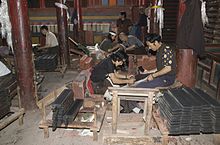Gonchen Monastery
| Gonchen Monastery | |
|---|---|
Tibetan transcription(s) Tibetan: སྡེ་དགེ་དགོན་ཆེན Wylie transliteration: sde dge dgon chen Other transcriptions: Dege Gönchen Chinese transcription(s) Traditional: 更慶寺 Simplified: 更庆寺 Pinyin: Gèngqìng Sì | |
 | |
| Religion | |
| Affiliation | Tibetan Buddhism |
| Sect | Sakya |
| Deity | Padmasambhava, Sakyamuni Buddha (Sakya Thukpa) and the future Buddha, Jampa or Maitreya |
| Location | |
| Location | Sichuan, China |
| Country | China |
 Location within China | |
| Geographic coordinates | 31°34′19″N 98°20′49″E / 31.572°N 98.347°ECoordinates: 31°34′19″N 98°20′49″E / 31.572°N 98.347°E |
| Architecture | |
| Style | The monastery has a notable design, with striped walls of white, dark red and gray, colors unique to the Sakya sect |
| Founder | Thang Tong Gyalpo (or Tangton Gyelpo)(1385-1464 CE) |
| Date established | 15th century |
| Part of a series on |
| Tibetan Buddhism |
|---|
 |
Gonchen (also known as Derge Monastery) is a large Sakya Tibetan Buddhist monastery in the town of Derge, in Sichuan, China. Gonchen is located in the ethnic Tibetan cultural region of Kham.
Description[]
The main chapel of the monastery is an extensive complex which resulted in it being called the "great monastery".[1] The monastery has a notable design, with striped walls of white, dark red and gray, colors unique to the Sakya sect of Tibetan Buddhism.[1]
Below the monastery itself is the famous Derge Parkhang (Printing House), built in 1729, where the Buddhist scriptures the Kangyur and the Tengyur and other Buddhist works are still printed from wooden blocks in traditional handwork.[1] The printing house, run by monks of the monastery, continues to use ancient techniques and uses no electricity. The roof is used for drying the printed sheets. It houses some 217,000 engraved blocks of scriptures from all Tibetan Buddhist sects including the Bon and about 2,500 pages are hand-produced each day by monks in the traditional manner. Upstairs in the same building older printers produce prints on both cloth and paper. Workers carve new wooden printing blocks in the administrative building opposite the monastery which is protected from earthquakes and fire by the goddess Drolma, an emanation of Tara.[2]
Tangyel Lhakhang is a secondary temple to the west of Gonchen Monastery's main temple.[3]
History[]
Gonchen Monastery was founded by Thang Tong Gyalpo (or Tangton Gyelpo) (1385-1464), a Buddhist yogi and polymath, physician, and treasure finder, renowned for founding of Ache Lhamo, the Tibetan opera, and the numerous iron suspension bridges he constructed throughout the Himalayan region. He is said to have made 108 of them, the most celebrated being the one over the Yarlung Tsangpo near modern Chushul. He is often shown in murals with long white hair and holding some chain links from his bridges.[1][4]
The monastery was completely destroyed during the Cultural Revolution.[5]
The monastery was restored in the 1980s and the three inner sanctums are dedicated to Guru Rinpoche (Padmasambhava), Sakyamuni Buddha (Sakya Thukpa) and the future Buddha, Jampa or Maitreya. On the way downhill to the printing press there is a small alley which leads off to the left to the Tangton Gyelpo Chapel (Tangyel Lhakhang).[2]
Recent events[]
January 27, 2009, a protest involving several Tibetan monks near the monastery was crushed by police by gunfire and detentions, according to the Tibetan Center for Human Rights and Democracy citing reports from the region.[6] On January 31 2009, the monks were released but 30 had been severely tortured.[7]
References[]
- ^ a b c d "Derge, the home of Tibetan Sutras". Tibet.to. Retrieved December 29, 2008.
- ^ a b Tibet. (2005) 6th Edition, p. 256. Bradley Mayhew and Michael Kohn. Lonely Planet. ISBN 1-74059-523-8.
- ^ Tsomu, Yudru (2015). The Rise of Gonpo Namgyel in Kham. Lanham, Maryland, USD: Lexington Books. p. 251. ISBN 9780739177921.
- ^ Tibet. (2005) 6th Edition, p. 26. Bradley Mayhew and Michael Kohn. Lonely Planet. ISBN 1-74059-523-8.
- ^ Trekking in Tibet , by Gary McCue, p241.
- ^ Tibetans Report Kardze Shooting, Radio Free Asia, 2009-01-30
- ^ Chinese authorities partied to provoke monks: report
External links[]
- Buddhist monasteries in Sichuan
- Sakya monasteries and temples
- Kham
